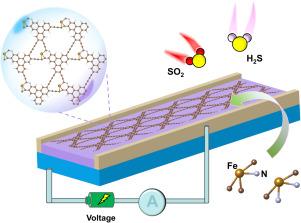Multi-scale correlation model: Theoretical analysis of the high-performance sensing mechanism of FeNx@TP-GDY for SF6 decomposition products
IF 6.9
2区 材料科学
Q2 CHEMISTRY, PHYSICAL
引用次数: 0
Abstract
Sulfur hexafluoride (SF) is widely used in electrical insulating switches. However, the aging of equipment causes SF decomposition and produces harmful gases such as HS and SO. This study investigates the adsorption behavior and sensing mechanism of SF decomposition products (SO and HS) on FeN@TP-GDY (x = 0, 1, 2) surfaces using density functional theory. We employ an innovative dual-site modification strategy to modify TP-GDY. Specifically, transition metal atoms are embedded into the substrate, and neighboring atoms are substituted with N. The results indicate that the coordination number of N atoms significantly affects the position of the d band center of Fe. By analyzing the frontier Wannier orbitals of Fe in the three materials, FeN2@TP-GDY shows stronger interaction due to greater overlap between the d orbital of Fe and the O p orbital. However, the response value of FeN@TP-GDY decreases with increasing N doping. Fe@TP-GDY exhibits excellent sensing response to SO (8467.5%) and HS (15209.6%) at room temperature, with a recovery time of only 22.4 s for HS. A multiscale “coordination–electronic–response” model is proposed to guide the design of TP-GDY sensors. Fe@TP-GDY shows great potential for early and real-time dual-gas fault monitoring in SF-insulated equipment.

多尺度关联模型:FeNx@TP-GDY对SF6分解产物的高效感知机理的理论分析
六氟化硫(SF6)广泛用于电气绝缘开关。但设备老化导致SF6分解,产生H2S、SO2等有害气体。本研究利用密度泛函理论研究了SF6分解产物(SO2和H2S)在FeNx@TP-GDY (x = 0,1,2)表面的吸附行为和传感机理。我们采用一种创新的双位点修饰策略来修饰TP-GDY。结果表明,N原子的配位数对Fe的d带中心位置有显著影响。通过分析三种材料中Fe的前沿万尼尔轨道,FeN2@TP-GDY显示出更强的相互作用,这是由于Fe的dx2−y2轨道与O pz轨道之间有更大的重叠。而FeNx@TP-GDY的响应值随着N掺杂量的增加而减小。Fe@TP-GDY在室温下对SO2(8467.5%)和H2S(15209.6%)具有良好的传感响应,对H2S的恢复时间仅为22.4 s。提出了一个多尺度“协调-电子-响应”模型来指导TP-GDY传感器的设计。Fe@TP-GDY在sf6绝缘设备双气故障的早期实时监测中具有很大的潜力。
本文章由计算机程序翻译,如有差异,请以英文原文为准。
求助全文
约1分钟内获得全文
求助全文
来源期刊

Applied Surface Science
工程技术-材料科学:膜
CiteScore
12.50
自引率
7.50%
发文量
3393
审稿时长
67 days
期刊介绍:
Applied Surface Science covers topics contributing to a better understanding of surfaces, interfaces, nanostructures and their applications. The journal is concerned with scientific research on the atomic and molecular level of material properties determined with specific surface analytical techniques and/or computational methods, as well as the processing of such structures.
 求助内容:
求助内容: 应助结果提醒方式:
应助结果提醒方式:


